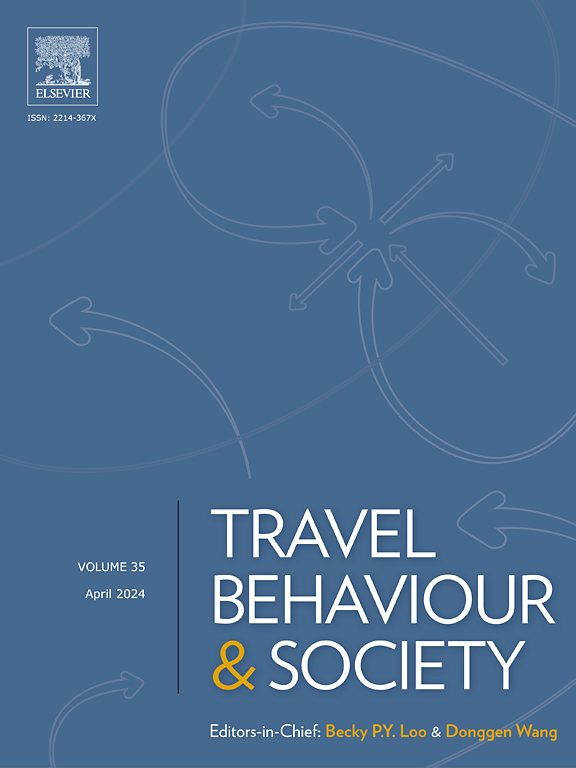Exploring dual-directional collective human mobility vulnerability and the built environment in places: Lessons from the COVID-19 pandemic
IF 5.1
2区 工程技术
Q1 TRANSPORTATION
引用次数: 0
Abstract
Place-level human mobility reflects the collective movement patterns of individuals and groups within defined geographic areas for specific mobility patterns. The COVID-19 pandemic has underscored the pressing concerns on mobility vulnerability during urban crisis. While socioeconomic disparities in mobility disruptions have been thoroughly documented, the impact of the built environment during the pandemic remains inadequately explored. Moreover, the vulnerability of collective human mobility in specific places, considering dual-directional patterns of both incoming and outgoing behaviors, is not well understood. This study utilizes extensive mobile phone data to investigate human mobility vulnerability across U.S. cities at the census block group (CBG) level during COVID-19, focusing on both incoming and outgoing mobility patterns. By integrating socioeconomic and built environment factors, we aim to identify the determinants that influence place-level mobility vulnerability in response to the pandemic. We assess year-over-year disparities in bidirectional mobility density, dwell time, and distance between 2019 and 2020 to evaluate their vulnerabilities in CBGs. The results reveal significant roles of built environment variables on the vulnerability and robustness of various mobility patterns. Our findings underscore the pronounced advantages and drawbacks of the built environments such as developed open space, retail density, employment diversity, job-worker balance, walkability, and transit service frequency on specific patterns of incoming and outgoing mobility vulnerability. Furthermore, interventions in the built environment aimed at promoting sustainable mobility should also consider the potential threats associated with mobility vulnerability. These insights provide practical implications for post-pandemic planning initiatives designed to enhance resilience.
探索人类双向集体流动脆弱性和地方建筑环境:2019冠状病毒病大流行的教训
地方层面的人类流动反映了个人和群体在特定地理区域内的集体流动模式。2019冠状病毒病大流行凸显了城市危机期间流动性脆弱性的紧迫问题。虽然已全面记录了交通中断方面的社会经济差异,但大流行期间建筑环境的影响仍未得到充分探讨。此外,考虑到进出行为的双向模式,在特定地方,人类集体流动的脆弱性还没有得到很好的理解。本研究利用广泛的手机数据,在2019冠状病毒病期间调查美国城市人口普查群体(CBG)层面的人类流动性脆弱性,重点关注进出流动性模式。通过综合社会经济和建筑环境因素,我们的目标是确定影响地方一级流动脆弱性的决定因素,以应对大流行。我们评估了2019年至2020年双向迁移密度、停留时间和距离的逐年差异,以评估它们在CBGs中的脆弱性。研究结果表明,建筑环境变量对各种流动模式的脆弱性和稳健性具有重要影响。我们的研究结果强调了建筑环境的明显优势和劣势,如开发的开放空间、零售密度、就业多样性、工作-工人平衡、步行性和公交服务频率对进出流动性脆弱性的特定模式。此外,旨在促进可持续流动性的建筑环境干预措施也应考虑到与流动性脆弱性相关的潜在威胁。这些见解为旨在增强复原力的大流行后规划举措提供了实际意义。
本文章由计算机程序翻译,如有差异,请以英文原文为准。
求助全文
约1分钟内获得全文
求助全文
来源期刊

Travel Behaviour and Society
TRANSPORTATION-
CiteScore
9.80
自引率
7.70%
发文量
109
期刊介绍:
Travel Behaviour and Society is an interdisciplinary journal publishing high-quality original papers which report leading edge research in theories, methodologies and applications concerning transportation issues and challenges which involve the social and spatial dimensions. In particular, it provides a discussion forum for major research in travel behaviour, transportation infrastructure, transportation and environmental issues, mobility and social sustainability, transportation geographic information systems (TGIS), transportation and quality of life, transportation data collection and analysis, etc.
 求助内容:
求助内容: 应助结果提醒方式:
应助结果提醒方式:


